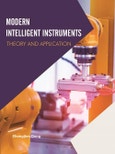This textbook serves as a guide for readers learning about the technical design of intelligent instruments, that is, instruments designed to collect information about the performance of other electronic devices and systems. The book introduces the readers to the concept of intelligent instrumentation and guides them on more advanced aspects of the subject including signal detection and analysis, data processing, performance analysis, and data communication. Practical examples are also provided in the latter half of the book to blend the theoretical concepts with applied knowledge for the benefit of the reader.
Key Features:
- Features 10 chapters covering key topics related to intelligent instrument design and operation
- Provides theoretical knowledge of fundamental concepts
- Provides practical examples of working instrument models (online equipment monitoring system and a mobile robot)
- Provides notes on the use of packages such as MATLAB, ARGUINO and Proteus to develop intelligent instruments
- Presents information in a simple, easy-to-understand format which is reader friendly
- Presents handy chapter notes and references for the reader
Modern Intelligent Instruments - Theory and Application is a useful textbook for engineering students and technical apprentices learning about instrumentation and PCB design and testing.
Table of Contents
Chapter 1 The Concept of Intelligent Instrument
1.1. The Introduction of Measurement
1.1.1. The History of Instruments
1.1.2. The Main Concepts of This Subsection
1.1.3. Development of Measurement and Metrology
1.2. The Intelligent Instrument and Its Composition
1.2.1. Eight Kinds of Test & Metering Instruments
1.2.2. Learning Example: Oscilloscopes
1.2.3. The Intelligent Instrument
1.3. The Example of Intelligent Instrument
Problem
References
Chapter 2 The Signal Detection and Analysis Technology in Intelligent Instrument
2.1. The Structure Principle of Data Acquired System
2.1.1. Multiplexer
2.1.2. Sample and Hold
2.1.3. An Analog-To-Digital Converter
2.1.4. The Simulation of Adc and Example
2.2. Noise Analysis Technology
2.2.1. Noise Types and Color Noise
2.2.2. Noise Simulation Model Or Implement Codes
2.2.3. Noise Analysis Technologies
2.3. The Weak Signal Detection
Problems
References
Chapter 3 The Data Processing Technology of Intelligent Instruments
3.1. The Measurement Uncertainty in Intelligent Instruments
3.2. The Data Processing Algorithms of Intelligent Instruments
3.2.1. The Data Filter Arithmetic
3.2.2. Fast Fourier Transform Arithmetic
3.2.3. Sinusoid Pulse Width Modulation Arithmetic
3.2.4. Pid Arithmetic
3.3. The Inverse Problem and Its Processing Method
3.3.1. Example of Scale in Intelligent Instrument Design
3.3.2. Methodologies in Intelligent Instrument Design
3.4. The Intelligent Computing
3.4.1. The Deep Learning Arithmetic
3.4.2. The Neural Networks
3.4.3. The Global Optimization Problem
Problem
References
Chapter 4 The Performance Analysis of Intelligent Instrument
4.1. The Accuracy and Intelligent Instrument Design Theory
4.1.1. The Accuracy Design Theory
4.1.2. The Design of Experiments
4.2. Software Test
4.3. Reliability Engineering of Intelligent Instrument
4.3.1. The Concept of Reliability
4.3.2. Reliability Program Plan and Assessment
4.3.3. Reliability Analysis
4.3.4. Reliability Design
Problem
References
Chapter 5 The Data Communication and Input-Output Technology of Intelligent Instrument
5.1. The Data Communication Technology
5.1.1. IIC Bus
5.1.2. SPI Bus
5.1.3. EPA Bus
5.2. The Input-Output Technology
5.2.1. Organic Light Emitting Diode (Oled), Micro-Led
5.2.2. Human–Computer Interaction
Problem
References
Chapter 6 Proteus and Its Simulation Design Examples
6.1. The Foundational Design Example of Proteus
6.1.1. The Led and Key Design [1]
6.1.2. The 7-Seg Led and Matrix Key Design
6.1.3. The Lcd and Adc Examples
6.2. The Advanced Design Example of Proteus
6.2.1. The IoT Design by Proteus [3]
6.2.1. The IoT and Yun Design by Proteus
Problem
References
Chapter 7 Arduino and Matlab in Intelligent Instrument
7.1. Matlab in Intelligent Instrument
7.1.1. Predictive Maintenance Toolbox
7.1.2. Computer Vision System
7.1.3. Robotics System Toolbox
7.2. Arduino in Intelligent Instrument
7.2.1. Slam
7.2.2. Phm
Problem
References
Chapter 8 The Application of Intelligent Instrument: A Mobile Intelligent Instrument
8.1. The Wearable Intelligent Instrument
8.1.1. The Body Temperature Sensors
8.1.3. The Spo2 Test (Ppg) Sensors
8.1.4. The Respiration Rate Test Sensors
8.1.5. The Ecg Test
8.2. The IoT Intelligent Instrument
8.2.1. The Power Instrument Used in the IoT
8.2.2. The Vector Network Analyzer Used in the IoT
8.2.3. The Bluetooth Communication Technologies in the IoT [12]
8.3. The State-Of-The-Art Instruments and Their Applications
8.3.1. The Biopotential Measurements
8.3.2. The Sensor Tag Based on Cc2650 and Smartwatch
Problem
References
Chapter 9 The Advance of the Intelligent Instrument Applied in An Online Equipment Monitoring System
9.1. Some New State-Of-The-Art Instruments Or Systems
9.1.1. State-Of-The-Art Instruments of Siemens-Mindsphere
9.1.2. State-Of-The-Art Instruments of Honeywell
9.1.3. State-Of-The-Art Instruments of Abb
9.2. The Fault Tolerance of Condition Monitoring
9.3. The Fault Analysis [11]
9.4. The Fault Identifies and Diagnosis Problem [12]
Problem
References
Chapter 10 The Application of Intelligent Instrument: a Mobile Robot Instrument
10.1. The Concept of the Moving Robot and the Intelligent Instrument
10.2. The Smart Small Car and the Intelligent Instrument
10.3. The Smart Uav and the Intelligent Instrument
Problem
References
Samples

LOADING...
Author
- Changjian Deng







